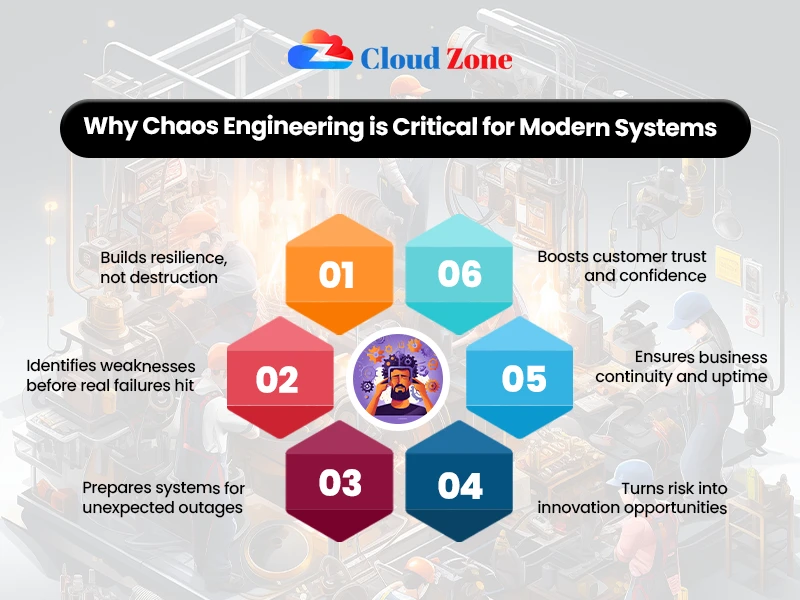Table of Contents
ToggleIntroduction
The reasons why Chaos Engineering Matters can be readily observed by looking at the current digital systems. Organizations have come to rely on cloud platforms, micro services, and highly complex networks that can act unpredictably. This complexity also brings fragility; the systems
can fail at any moment and resulting in downtime, which is detrimental to revenue and customer trust.
It is not the process of destroying, but the process of developing resiliency. Risky experiments can be run safely to identify the weaknesses within the organization and rectify them before they are hit by the real problems.
In this article, you will find what is chaos engineering, what is a chaos engine, and its testing.
We shall also briefly mention the position of the engineering chairs, the applicability of what is Gremlin chaos engineering, and how a metaphor of the tower of Babel survivors of chaos cheat engine clarifies the modern digital world.
At the conclusion, you will not only know why this matters, but also how it brings the future of reliable systems in 2025 and beyond.
Why Organizations Ask for Chaos
Companies that implement cloud or microservices are usually subjected to latent risks. Outage might occur due to network breakdowns, misconfigurations, or system failures. It is best understood whether we can be ready when the unexpected happens. Companies would like to know that their systems will remain operational even when failures are experienced. This engineering experiment provides control to teams instead of waiting until disasters take place. That is why leaders believe this is a discipline required in the world of contemporary engineering.
As an example, DevOps training in Chandigarh today can incorporate lessons on chaos experiments, as resilience is one of the major industry requirements.

Common Misunderstandings
The discipline is not understood by many applicants and even by engineers. There are myths such as:
- What is chaos engineering testing is not like regular quality assurance, think.
- The assumption that the application of a chaos engine implies the production of uncontrolled outages.
- Losing the memory that experiments should never be unsafe, immeasurable, or irreversible.
- Conflating the role of humans, and not only systems, in responses.
- Certainly, assuming that such a tool as what is Gremlin chaos engineering is the sole entry point.
Such confusion can be likened to the fact that people do not understand other ideas, like telemetry, where accurate information is central to control and quality.
The STAR Inspiration for Chaos
Situation: Complex systems, such as the tower of Babel survivors of chaos cheat engine, have communication failures.
Task: Engineers should be ready to work under the conditions of services collapsing suddenly.
Action: Teams implement experiments via a chaos engine to crash, simulate latency,
or outages.
Result: They get to know the speed at which the system gets back on its feet, how teams respond, and what can be done to enhance resilience.
The STAR approach can also be applied in explaining the adaptability in other areas, such as hybrid cloud, where various environments have to remain interconnected.
Discover how controlled chaos can protect your apps from real-world outages.
Top Reasons Chaos Adds Value
Why Chaos Engineering Matters comes down to a bottom line. It avoids losses, enhances customer confidence, as well as accelerates the rate of innovation. Organizations embrace resilience, and in the process, they can adjust rapidly in times of crisis. Leaders can answer the question of what is chaos engineering testing and find the evidence of stability and recovery time. This value extends beyond the technical advantages; this is a value that creates trust in teams and with customers.
Measurements such as Amazon CloudWatch are demonstrated, yet chaos confirms the ability of systems to respond to those measurements when failures occur.
Sample Scenarios of Chaos in 2025
Experiments in chaos engines in 2025 will include:
- Powering out data centres to prove failover.
- The monitoring of AI-based warnings is done in real time to alert the engineer.
- Breaking microservice: The redundancy of a microservice is measured by breaking the dependency between the two.
- Checking whether a hybrid workforce would be able to collaborate effectively in case of incidents.
- Automate controlled experiments with what are Gremlin chaos engineering tools.
Similar to how engineers compare the price of DevOps courses to select the optimal course, teams compare the results of the experiment to select the optimal resilience strategies.
Soft Skills in Chaos
Confidence: Teams must have confidence when simulating failures.
Flexibility: A leader should be flexible, similar to the chair of engineering, he should change strategy to outcome.
Teamwork: Engineers liaise interdepartmentally in times of anarchy.
Emotional Intelligence: Calm response in the event of actual outages.
Growth Mindset: All experiments give learning, not blame.
Such a combination of skills is equal to what you would get when reading about what a DevOps engineer is doing; it is never only about technology, but about attitude and cooperation.
Modern Relevance in 2025
The systems today require flexibility. Labor is mobile, markets are international, and services are 24/7. The reasons why Chaos Engineering Matters are more apparent than ever. Leaders need to respond to what this is not only technically but also in business terminology. Outages have an impact on revenue, reputation, and regulation. Chaos experiments have ceased to become optional; they are becoming a part of digital survival. They confirm recovery times and protect trust in an unmatched manner against any other method of testing.
DevOps courses online and other remote training platforms increasingly contain modules on resilience, demonstrating the extent to which chaos has become a relevant factor in education as well as practice.
Stay ahead of the curve by learning AI-powered
Mistakes Teams Still Make
Even in 2025, typical errors are:
- Taking chaos as an option rather than a necessity.
- Replicating generic playbooks without changing.
- Running one-off experiments without follow-up.
- Forgetting to link the outcomes to business purposes.
- Not using such tools as what is Gremlin chaos engineering without knowing the basics.
Such errors are expensive, particularly in areas where cloud growth is enjoying a boom. As an example, the 2 billion dollars in investments in Indian data centers by AWS exemplify the extent to which infrastructure has to develop, and the risks that have to be put to the test.
Building Strong Outcomes
- Begin small and expand the experiments.
- Record findings in a way that the leader and the engineering chairs can see results.
- Also, align experiments to company objectives, not merely technical interest.
- Point out at least one of the key improvements following each round of testing.
- Conclude any cycle by asking how resilience can translate to customer trust.
The same can be applied when performing with such tools as OneDrive– little steps create lasting habits of reliability.

Conclusion:
The discipline proves again and again that Why Chaos Engineering Matters is not about breaking systems but about building resilience. It defines and clarifies what is a chaos engine, and demonstrates what is chaos engineering testing as a practice. It also shows why tools like Gremlin chaos engineering help scale, and how leaders such as the chair of engineering play a vital role. Even the metaphor of the tower of babel survivors of chaos cheat engine illustrates how systems survive diversity.
Just as resources like AWS Skill Builder or GCP certification prepare professionals for the future, this engineering prepares systems for the unexpected.
Chaos is not destruction: it is discipline.
Are you ready to prepare your team for tomorrow’s failures?
Begin with a single small experiment, today, discuss the findings with your chair of engineering, and develop a resilient culture. Bear in mind, there are never any failures, but in chaos, there is no doubt about survival.
For more on modern practices like hybrid cloud, resilience testing, and DevOps, explore resources to expand your expertise.

Sukhamrit Kaur
Sukhamrit Kaur is an SEO writer who loves simplifying complex topics. She has helped companies like Data World, DataCamp, and Rask AI create engaging and informative content for their audiences. You can connect with her on LinkedIn.



